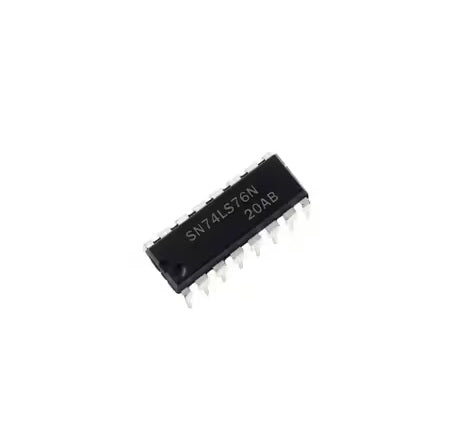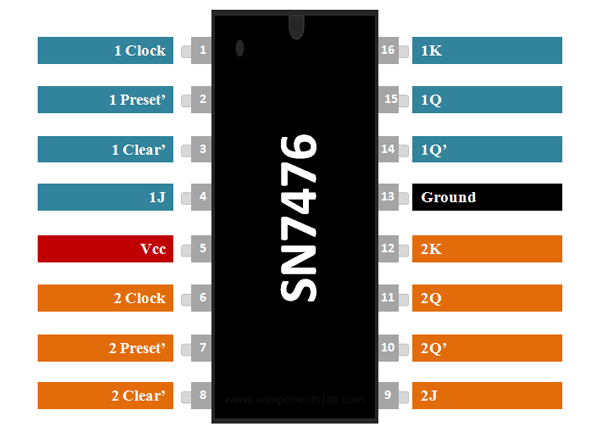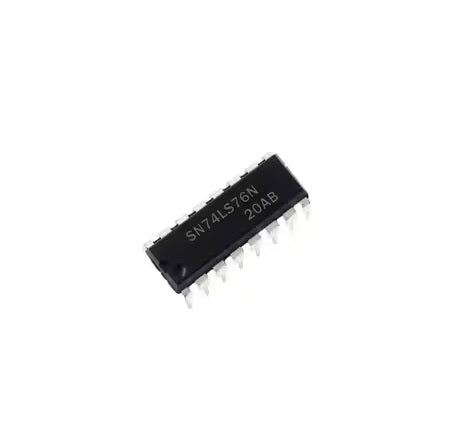Shop All Categories
Trending products
Robot Pi Shop
IC 7476 Dual J-K Flip-Flop, Preset & Clear
The 74LS76 IC is essentially synonymous with JK flip-flops, primarily employed for bit storage but also demonstrating utility in various other applications. Several key attributes contribute to the widespread popularity of JK flip-flops, including:
The clock input feature.
The presence of preset input pins.
Notably, JK flip-flops exhibit state transitions upon the application of a clock pulse signal, which can manifest as either a positive or negative edge. Furthermore, the 74LS76 possesses the capability to filter out invalid output conditions.
7476 IC Pin Diagram
The following is the pin description of 74LS76:
| Pin No. | Pin Name | Description |
| 5 | Vcc | Powers the IC typically with 5V |
| 13 | Ground | Connected to the ground of the system |
| JK Flip Flop – 1 / JK Flip Flop - 2 | ||
| 1,6 | Clock-1/ Clock-2 | These pins must be provided with clock pulse for the flip flop |
| 2,7 | Preset-1 / Preset-2 | Preset input pin drives Flip Flop to a set state |
| 16, 12 | 1K/ 2K | Input pin of the Flip Flop |
| 4,9 | 1J / 2J | Another Input pin of the Flip Flop |
| 14, 10 | 1Q(bar) / 2Q (bar) | Inverted output pin of Flip Flop |
| 15,11 | 1Q / 2Q | Output Pin of the Flip Flop |
| 3,8 | 1 CLR (bar)/ 2 CLR (bar) | Clear input pin drives Flip Flop to a reset state |
74ls76 Pin Details:
Pin 1(1 CLK): Clock input for the first JK flip-flop. A HIGH to LOW pulse influences this flip-flop.
Pin 2(1 PRE'): Preset input for the first flip-flop, setting 1Q to HIGH. Active LOW.
Pin 3(1 CLR'): Clear input for the first flip-flop, resetting its output. Active LOW.
Pin 4(Input 1, J): First input for the first flip-flop, receiving data (HIGH or LOW).
Pin 5(Vcc): Power supply pin, providing operational power to the IC.
Pin 6(2 CLK): Clock input for the second JK flip-flop. A HIGH to LOW pulse affects the IC.
Pin 7(2 PRE'): Preset input for the second flip-flop, setting 2Q to HIGH. Active LOW.
Pin 8(2 CLR'): Clear input for the second flip-flop, resetting its output. Active LOW.
Pin 9(Input 2, J): First input for the second flip-flop, receiving data (HIGH or LOW).
Pin 10(2Q'): Second output for the second flip-flop, providing the inverted output of Pin 11.
Pin 11(OUTPUT 2Q): First output for the second flip-flop, offering its output bit.
Pin 12(Input 2K): Second input for the second flip-flop, receiving the second data bit (HIGH or LOW).
Pin 13(GND): Ground pin, creating a common ground with the power supply and other devices if required.
Pin 14(1Q'): Second output for the first flip-flop, supplying the inverted output of Pin 15.
Pin 15(OUTPUT 1Q): First output for the first flip-flop, providing its output bit.
Pin 16(Input 1K): Second input for the first flip-flop, receiving the second data bit (HIGH or LO
Default Title
Robot Pi Shop
Pickup available,usually ready in 1 hour
Ground Floor Shop, Sayde Street, Fanar Matn 1202
Fanar
Lebanon




IC-000043-DVR
| Price |
|---|
| SKU |
| Rating |
| Discount |
| Vendor |
| Tags |
| Weight |
| Stock |
| Short Description |
Description here
Description here
